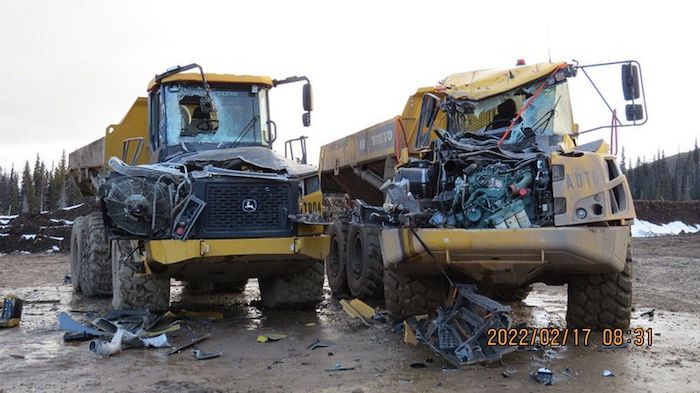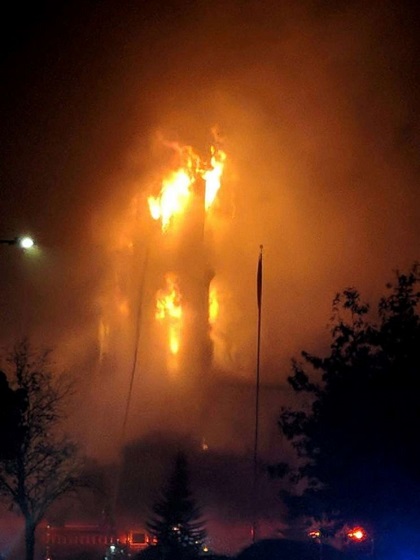Frontier Centre for Public Policy
Canada’s eco-extremism threat is flying under the radar

From the Frontier Centre for Public Policy
The dangerous rise in eco-extremism in Canada is fueled by identity politics and exaggerated climate anxieties
The rhetoric surrounding “decolonization” and identity politics, coupled with exaggerated concerns about climate change, is giving rise to a dangerous form of eco-extremism that is spreading unchecked across the country.
This trend is vividly illustrated by the February 2022 terrorist assault on a Coastal GasLink pipeline project site in British Columbia. Approximately 20 masked assailants armed with axes and flare guns descended upon the site, instilling fear among security personnel and workers and causing an estimated $20 million in damages, as reported by B.C.’s Independent Contractors and Business Association.
Had the mainstream media exercised greater journalistic diligence, they might have discerned the ideological motives behind the attackers, evident from the clues they left behind.
The Frontier Centre for Public Policy recently released a major report highlighting the looming threat of eco-extremism in Canada. Our research reveals a nexus with an “Indigeno-anarchist” movement that remains largely unmonitored by governmental bodies, media outlets, and security agencies.
Regrettably, governmental and media attention remains disproportionately fixated on extremism associated with the right-wing factions. Recall the undue emphasis on the convoy protests, falsely linked to extremist foreign influences.
Similarly, Canadians witnessed a tendency to downplay instances of arson and vandalism targeting nearly 100 churches despite clear links to fabricated allegations concerning residential schools.
Furthermore, a recent RCMP report warned about the dangers of “paranoid populism,” potentially stoking civil unrest over declining economic conditions. In February, CSIS voiced its concerns regarding an alleged “anti-gender” movement, purportedly posing a violent threat to the LGBTQ+ community in Canada. However, despite intense public debates on gender-related issues, no evidence emerged to support such claims of violence.
Elite institutions are fixated on exaggerated threats from the right while overlooking the looming threat emanating from far-left factions championing “decolonization” ideals, radicalized by anti-fossil fuel rhetoric.
The origins of this rhetoric can be traced to the toxic influences within Canada’s publicly funded universities, where self-proclaimed “Indigeno-anarchists” conduct recruitment drives and propagate toxic ideologies under the guise of academic freedom.
The masked, axe-wielding assailants of the Coastal GasLink attack left behind graffiti bearing the messages “LAND BACK” and “CGL EVICT,” which highlighted a broader ideological stance. While “LAND BACK” initially stemmed from Indigenous movements reclaiming sovereignty over ancestral lands, it has been co-opted by non-Indigenous actors subscribing to identity politics and anarchism, who resort to sabotage and property damage in pursuit of their agenda. The term became identified with the meaningless term “decolonization” and became associated with groups that wanted to “dismantle White supremacy.”
These groups, driven by a cocktail of identity politics and alarmist views on climate change, perceive fossil fuel projects as primary contributors to environmental degradation, disregarding nuances and complexities of the issue.
In recent years, many of these self-righteous anarchists rallied around the Wet’suwet’en conflict and its complicated relationship with the Coastal GasLink pipeline, aligning themselves with one faction opposed to the project despite broader community support. Although most activists opposing Coastal GasLink were peaceful, some resorted to unlawful tactics, including intimidation and property damage, tantamount to terrorism under the Criminal Code.
Lacking nuance, they attached themselves to one segment – a group claiming to be hereditary chiefs from the community but who were receiving funds from foreign environmental foundations – that was opposed to the project despite strong community support from the elected band government and the wider Wet’suwet’en community.
The RCMP deserves credit for establishing a specialized unit to address these attacks. However, it is time for Canada to finally address the “Indigeno-anarchist” threat.
First Nations must condemn these groups in one voice, and governments must use the Criminal Code and legislation to address eco-terrorist rhetoric and acts.
Joseph Quesnel is a senior research fellow with the Frontier Centre for Public Policy.
Frontier Centre for Public Policy
It’s Time To Stop Church Arsons And What Fuels Them

From the Frontier Centre for Public Policy
By Lee Harding
Religious freedoms and the right to worship have been a recognized hallmark of civilized societies for centuries. The preamble of Canada’s constitution says our country is built on the principles that acknowledge the supremacy of God and the rule of law. In defiance of both, almost 600 Canadian places of worship have suffered arson in recent years. Nothing could be more unCanadian.
The stats were revealed by Member of Parliament Marc Dalton following a formal inquiry to the federal government. The response showed 592 arsons had been set on places of worship between 2010 and 2022. they rose from 58 in 2020 to 90 in 2021, then down to 74 in 2022.
The peak coincides with claims made in May of 2021 that the remains of 215 school children had been discovered on the site of the former Kamloops Residential School.
Although Prime Minister Justin Trudeau called a subsequent wave of church burnings “unacceptable and wrong” he also called their likely motivations “real and fully understandable.” This hardly doused the flames.
These arsons far outnumber those made on Canadian churches in the 1920s by the Ku Klux Klan, which opposed non-Protestants and non-whites. In those years the KKK desecrated Sarnia’s St. Joseph’s Catholic Church. They killed ten people when they set Saint-Boniface College in Winnipeg on fire. They also burned the Cathedral-Basilica of Notre-Dame de Quebec. In 1926, three Klan members were jailed after they blew up St. Mary’s Roman Catholic Church in Barrie, Ont.
The Klan soon fizzled out, seemingly unlike these recent church burnings. The 110-year-old Notre-Dame-des-Sept-Allégresses Catholic church burned down in Trois-Rivières, Quebec last month, but whether arson was involved has not been confirmed.
The presence of bodies underneath the former residential school in Kamloops has not been confirmed either. A 1924 septic field could also account for soil anomalies found there by ground-penetrating radar. Eight million federal tax dollars spent to investigate the site have yielded no remains and details on how the money was spent are sketchy. It’s high time the site was excavated to confirm or rule out the graves and do autopsies on any corpses found there.
Federal funds also fuel the Canadian Anti-Hate Network (CAHN), the Orwellian title for a group that fuels resentment against socially conservative organizations with negative characterizations. On August 7, CAHN published “40 Ways To Fight The Far-Right: Tactics for Community Activists in Canada” thanks to $640,000 from Ottawa.
“White boys and men make up the majority of people involved in hate-promoting movements,” the handbook explains. Pro-life and pro-parent groups, CAHN says, are among those “characterized by racism, antisemitism, Islamophobia, misogyny, anti-2SLGBTQ+ views, and pro-colonialist/ anti-Indigenous bigotry.”
CAHN says the Catholic-dominated, pro-life organization Campaign Life Coalition is a “hate movement.” Liberty Coalition Canada, a legal defence organization, and the activist organization Action4Canada are similarly denigrated for their alleged belief that Canada was founded on Christian values and attempts to reassert such values.
Meanwhile, the CAHN guide advocates “antifascist” doxing, including infiltration of right-leaning organizations. getting people fired, and ending friendships.
Dalton’s Bill C-411 the “Anti-Arson Act” would do more to deter hate-motivated crimes than CAHN ever will. The legislation would punish those who set fires and explosions at religious places. A first offence would get a mandatory five-year jail sentence, while subsequent offenses would prompt seven years.
When respect for the supremacy of God and the rule of law fail, rights give way to wrongs. It’s time to stop the fires and the disputable claims that fuel them, and restore respect for people of faith, their right to worship, and their places of worship.
Lee Harding is a Research Associate for the Frontier Centre for Public Policy.
Censorship Industrial Complex
Another Mass Grave?

No. One outrageous lie was quickly discounted, yet another lives on, to the detriment of everybody involved.
From the Frontier Centre for Public Policy
The Kamloops claim didn’t come out of the blue. The TRC’s well-publicized “missing children” wild goose chase thoroughly indoctrinated indigenous communities. It convinced foolish people, like Casimir, Leah Gazan and Kimberley Murray, that thousands of “missing children” had been secretly buried all across Canada.
“My brother Rufus saw them take all those children and stand them up next to a big ditch, and then the soldiers shot them all and they all fell into that ditch. Some of the kids were still alive and they just poured the dirt in on top of them. Buried them alive.”
This mass murder happened in 1943 — not in Nazi-held Europe, but in Brantford, Ontario.
So, there you have it — the personal story of a residential school “survivor” describing the day the Canadian Army lined up 43 Indian children in front of a residential school at Brantford, Ontario, shot them and dumped their bodies into a mass grave. The May 27, 2021 announcement that the remains of 215 former students of the Kamloops residential school wasn’t the first time that a claim about sinister residential school deaths and clandestine burials had been made.
This Brantford story is obviously untrue. Any reasonably well-informed person with a lick of sense would know that at a glance.
But that didn’t stop the claim from making the social media rounds for years. According to the fact-check tens of thousands of people have read this bogus claim over the years, and many appear to have believed it completely. In fact, despite the fact checks proving that the claim was entirely false it continues to circulate today.
Both the Kamloops and Brantford claims came basically from the same place — the strange mind of a defrocked United Church Minister, Kevin Annett. It was Annett who created the bogus Brantford claim. In a strange twist, the picture at the top of the page — said to be from Brantford — is actually a photo of the former Kamloops Indian Residential School, as it looked in the 1920s.
And it was Annett who inspired the TRC’s misguided “missing children/unmarked graves” wild goose chase that, in turn, inspired Chief Rosanne Casimir to make the Kamloops claim. Both claims were equally and obviously false: The Kamloops claim was that the “remains of 215 children were found.” In fact, only radar blips (anomalies) were detected- blips that turned out. to most likely be from previous excavations, and not graves. Casimir and Annett both knew that they were making false claims.
Annett’s bogus claims come from his imaginative reworking of stories of “survivors” that he publicized in his blogs, books, interviews and movies.
His most famous movie is Unrepentant. This movie has been viewed by tens of thousands of Canadians, particularly in indigenous communities, such as the Tk’emlups community at Kamloops.
It has won awards, and been praised by eminent people, such as Noam Chomsky. Despite being every bit as false as the claim that the Canadian army shot 43 indigenous children, it actually convinced Member of Parliament, Gary Merasty, that it was accurate history. It is nothing short of amazing that this highly suggestible MP was then able to convince the equally gullible, and newly appointed TRC commissioners that there were many thousands of such “missing children”, as Annett alleged.
The TRC commissioners then launched their “missing children/unmarked graves” campaign despite having no mandate from the federal government to do so. (Independent researcher, Nina Green, describes this in detail here.)
You see, the Kamloops claim didn’t come out of the blue. The TRC’s well-publicized “missing children” wild goose chase thoroughly indoctrinated indigenous communities. It convinced foolish people, like Casimir, Leah Gazan and Kimberley Murray, that thousands of “missing children” had been secretly buried all across Canada.
Indigenous people became hooked on these stories.
Annett’s most famous book is his 393 page opus, “Hidden No Longer.” That book introduced the idea that the deaths of these thousands of “missing children” (his estimates range from 50,000 to 250,000, depending on the telling) constituted genocide. It is absolutely shocking that our MPs actually voted to condemn Canada of genocide based essentially on Kevin Annett’s bogus claims.
Based on those same bogus claims Annett was hired by the Brantford Mohawk community in 2011 to dig up the graves that he claimed existed in the apple orchard area of their residential school. According to Annett, these were the graves of indigenous students who had been secretly killed and buried in the apple orchard at the school, with the forced help of fellow students.
Sound familiar? It should. That was essentially the same grisly tale repeated by Chief Rosanne Casimir years later in Kamloops. (See above.)
Except that the wiser folks within the Brantford Mohawk community twigged on to Annett’s tricks. And when Annett was found on the streets of Toronto, waving around chicken bones, and pretending that they were the bones of children he had unearthed at Brantford, the Mohawk elders came together and publicly denounced Annett as a fraud at a community meeting. They then banished him from their community.
Unfortunately, Casimir became a useful idiot for Annett — just as the gullible TRC commissioners did — and no such leadership has yet come forward from the wiser elements within the Kamloops indigenous community. Those folks are silent, while the more vocal contingent are still sticking to their story that the soil anomalies are the “remains of 215 children,” and not what they almost certainly are — 1924 septic excavations.
So, the questions should be asked: Is the claim that the Canadian army shot 43 indigenous children, and dumped them in a mass grave, any more or less believable than the claim that priests killed and secretly buried 215 children at Kamloops, (or any of the copycat claims that followed it?)
What is it about that Mohawk claim that gives it appeal to only the most gullible among us, while the equally improbable Kamloops claim is still taken seriously by so many people?
On the surface, both claims are outrageous, and have no real evidence to support them. Quite the contrary, every Canadian history book ever written is cogent evidence that both stories are false. But the Mohawk claim was dismissed as the nonsense it obviously was, while the Kamloops claim lives on.
At least part of the answer to those questions appears to be in the response of the government in power, and the media to the claims. If the Brantford claim had been met by a prime minister who immediately ordered that flags be lowered, and offered hundreds of millions of dollars to any other indigenous communities who wanted to make similar claim, no doubt that Brantford claim would have been taken seriously.
Or, if the Brantford claim had been made in a time when a highly ideological CBC would ask no questions, and blindly promote the claim, the results might have been entirely different. As it is, the Brantford claim died a merciful death, while the equally specious Kamloops genocide claim still languishes like a stinking albatross around the neck of every Canadian.
Although the international community is increasingly broadcasting the obvious fact that the Kamloops claim is bogus Canada’s media remains asleep. That is not likely to change until leadership changes in Ottawa, and at the CBC. Pierre Pollievre, when questioned on this topic, stated clearly that he stands for historical truth, accuracy, and a full investigation into all questions pertaining to claims about residential school deaths. Hopefully, that means that excavation and a full inquiry will follow.
But Tk’emlups indigenous elders better wake up, like the Mohawk elders did. You are not doing your communities a favour by letting politicians and journalists treat you like children, by pretending to believe your bizarre claims. These false claims are already doing great damage.
Fortunately, there are many thoughtful indigenous people who do not blindly accept the claims about murderous priests and secret burials.
Here is one such wise indigenous person. He is a priest, and he is willing to do what our federal government and our CBC failed to do from the beginning namely to intelligently discuss the issue.
Thoughtful people like this need to be involved in a full investigation that will clear the air about the Kamloops claim, and get Canada back on track.
Brian Giesbrecht, retired judge, is a Senior Fellow at the Frontier Centre for Public Policy.
-

 Brownstone Institute22 hours ago
Brownstone Institute22 hours agoThe Most Devastating Report So Far
-

 Economy1 day ago
Economy1 day agoCOP 29 leaders demand over a $1 trillion a year in climate reparations from ‘wealthy’ nations. They don’t deserve a nickel.
-

 Censorship Industrial Complex1 day ago
Censorship Industrial Complex1 day agoAnother Mass Grave?
-

 ESG9 hours ago
ESG9 hours agoCan’t afford Rent? Groceries for your kids? Trudeau says suck it up and pay the tax!
-

 Alberta1 day ago
Alberta1 day agoMAiD In Alberta: Province surveying Albertans about assisted suicide policies
-

 Energy1 day ago
Energy1 day agoOttawa’s proposed emission cap lacks any solid scientific or economic rationale
-

 Alberta1 day ago
Alberta1 day agoOn gender, Alberta is following the science
-

 International10 hours ago
International10 hours agoElon Musk praises families on X: ‘We should teach fear of childlessness,’ not pregnancy


